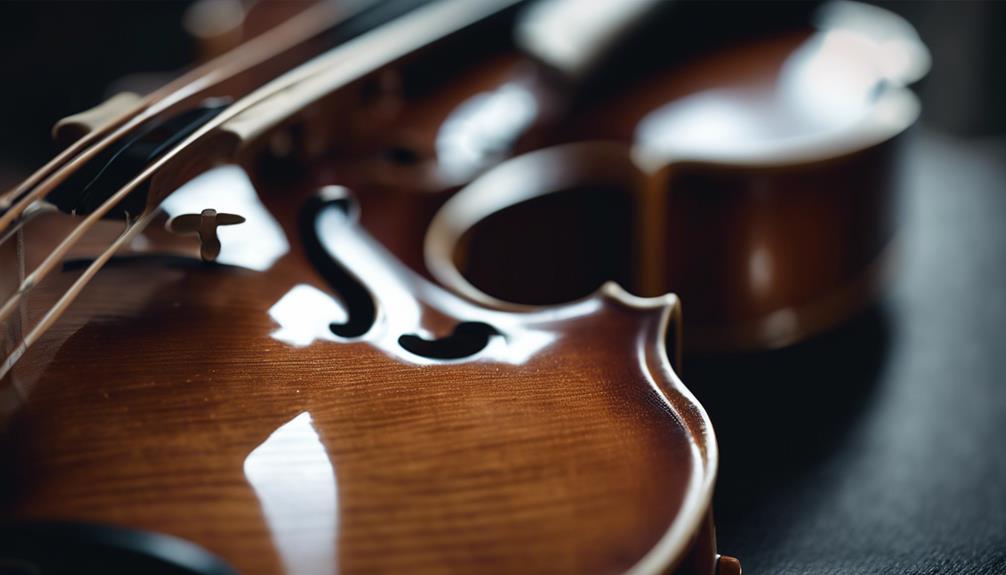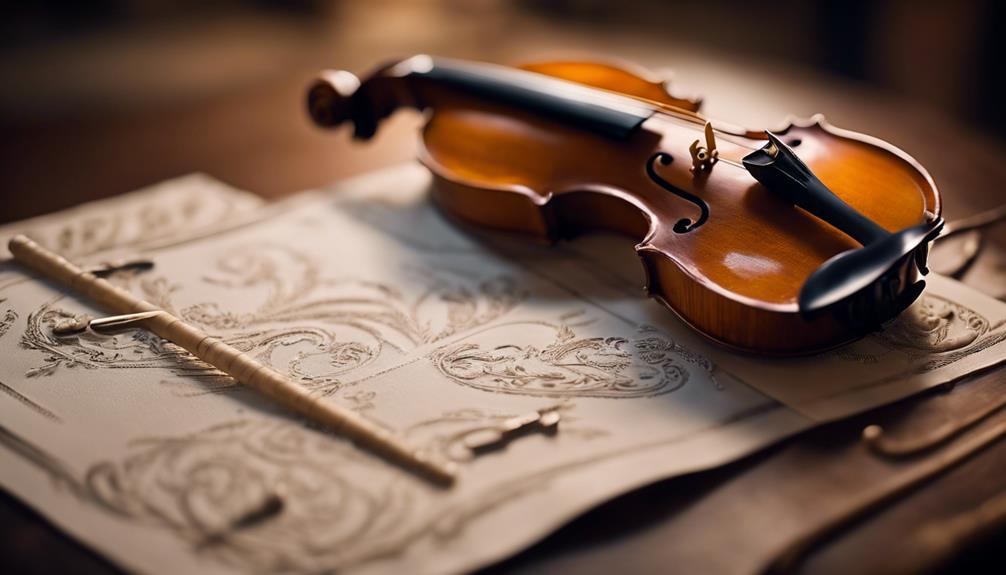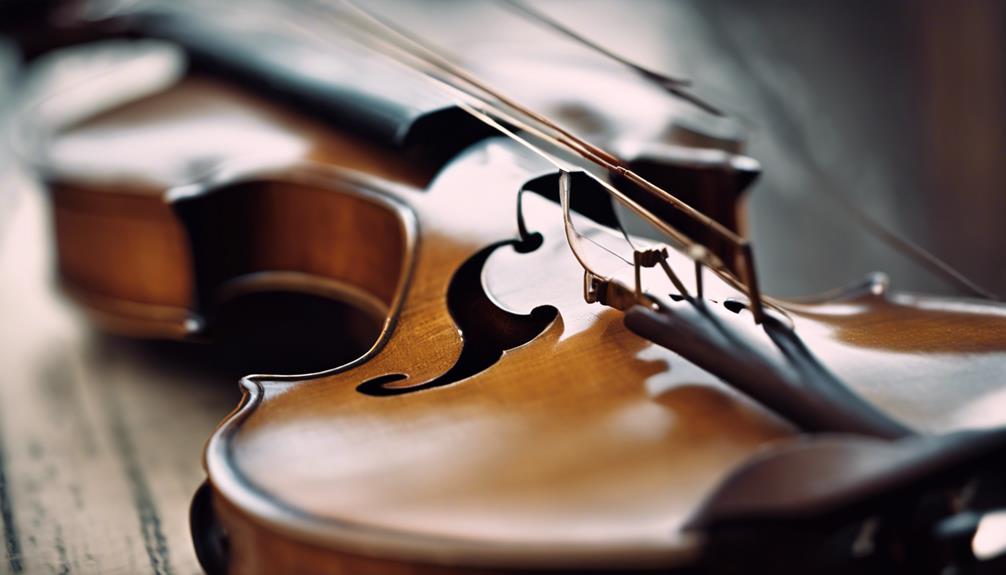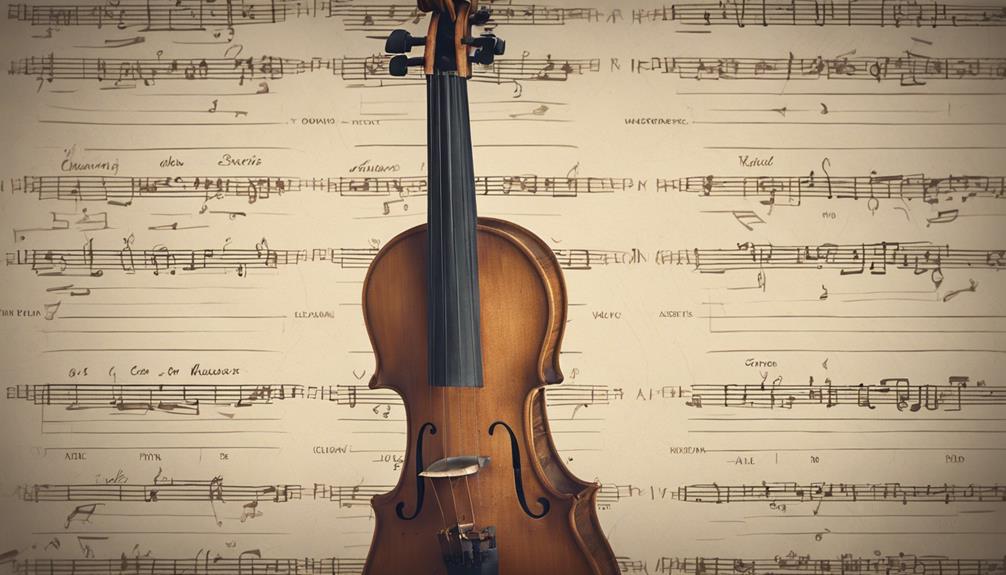Violin Parts Names: A Comprehensive Guide for Beginners and Enthusiasts
As you explore the violin, familiarize yourself with its parts: top plate, back plate, ribs, F-holes, neck, fingerboard, scroll, pegbox, tuning pegs, bridge, tailpiece, strings, and bow. The top plate and back plate impact sound, while the F-holes optimize resonance. The neck and fingerboard affect playability and pitch. The scroll adds aesthetic value. Pegbox houses tuning pegs essential for adjustment. The bridge and tailpiece support strings and impact sound quality. Strings vary in material and placement for unique tonal qualities. The bow, consisting of stick, hair, frog, and screw, creates desired tone. Components like the soundpost further enhance resonance and performance.
Main Body of the Violin

Now, let’s explore the intricate components that make up the main body of the violin. The body consists of the top plate, back plate, and ribs, all meticulously crafted to produce a resonant sound. Additionally, the f-shaped soundholes play a crucial role in shaping the instrument’s acoustics and tone.
Body components
As you explore the main body of the violin, you will encounter three primary components: the top plate, back plate, and ribs. The top plate, also known as the belly, is the front part of the violin that plays a crucial role in producing sound. The back plate is situated opposite the top plate, while the ribs connect the two plates, forming the sides of the instrument.
Top plate (belly)
Located on the top of the violin, the top plate, also known as the belly, is a crucial component that contributes significantly to the instrument’s tone and resonance. Its construction, often made of spruce, impacts sound projection. Aesthetically, the top plate can feature intricate designs, but its primary function lies in affecting tonal qualities. The belly’s thickness, arching, and overall craftsmanship play a vital role in producing rich and balanced sound.
Back plate
The back plate of the violin, also referred to as the main body, serves as a fundamental element in the instrument’s structure and sound production. Back plate construction is crucial for determining the violin’s resonance and tonal characteristics. Restoration of the back plate is often intricate work, requiring skilled craftsmanship. The back plate varnish not only protects the wood but also contributes significantly to the violin’s overall sound quality.
Ribs (sides)
Examine the violin’s ribs (sides) as crucial components of the instrument’s main body structure, playing a significant role in supporting the overall integrity and shape of the violin. The rib structure, essential for sound production, contributes to the resonance and tonal quality of the instrument. Additionally, side decoration on violins has historical significance, reflecting different artistic styles and cultural influences over the centuries.
Soundholes
As a violinist, you may have noticed the elegant F-holes carved into the main body of your instrument. These soundholes serve a crucial purpose in allowing the violin to resonate and produce its rich, full sound. By carefully shaping and positioning these F-holes, luthiers ensure that the violin can project its sound effectively, making them a vital component of the instrument’s design.
F-holes
Positioned symmetrically on either side of the violin’s body, the F-holes play a crucial role in shaping the instrument’s sound projection and resonance. Historically, these soundholes have evolved in design, with various variations seen in different violin models. The shape and size of F-holes can vary, affecting the tone and volume of the sound produced. Different designs have been experimented with over time to optimize sound quality and resonance.
Purpose and function
The soundholes of a violin, located on the main body of the instrument, serve a fundamental purpose in shaping the acoustic properties of the sound it produces. Historically, these openings have evolved from simple circular designs to the iconic f-shaped holes seen in modern violins. Innovations in technology have allowed for precise adjustments to the size and shape of the soundholes, influencing the instrument’s tone and resonance significantly.
Neck and Fingerboard
The neck of the violin is the long, slender piece that extends from the body, providing support for the fingerboard. This component plays a crucial role in determining the instrument’s overall playability and sound quality. The fingerboard, usually made of ebony, is a smooth, flat surface where the strings are pressed down to produce different notes and pitches.
Neck
The neck of a violin, made typically of maple, plays a critical role in the instrument’s overall sound and playability. Its shape and dimensions significantly affect how comfortably you can reach different notes along the fingerboard. Additionally, the secure connection between the neck and the body ensures stability and proper resonance during performance.
Material and shape
Crafted from durable materials like maple or mahogany, the neck of a violin is meticulously shaped to provide optimal support and stability for the instrument. In historical evolution, necks were often carved from one piece, while modern trends favor the use of multi-piece construction for increased strength. Varnish types like oil, spirit, or synthetic varnishes are carefully applied to protect and enhance the neck’s appearance.
Connection to the body
Carefully shaping the neck of a violin ensures a secure and stable connection to the body, crucial for optimal performance. The neck’s design impacts body connection, playing comfort, body alignment, and posture awareness. A well-crafted neck enhances the player’s ability to maintain proper posture, aligning the body for improved comfort during extended playing sessions. This alignment reduces strain, promoting a more enjoyable and sustainable playing experience.
Fingerboard
The fingerboard of a violin is typically made of ebony due to its durability and smooth surface. It plays a crucial role in playing by providing a precise location for the player’s fingers to press down on the strings, determining the pitch of the notes produced. Understanding the material and function of the fingerboard is essential for mastering the technique and sound production on the violin.
Material (ebony)
Ebony is commonly used as the material for the neck and fingerboard of violins due to its durability and smooth texture. Ebony properties include stability and resistance to wear, making it ideal for frequent finger contact. To maintain ebony, periodically clean with a soft cloth. Cleaning techniques involve using a damp cloth and avoiding harsh chemicals. Ebony’s density contributes to sound enhancement by providing a solid surface for the strings.
Role in playing
Crafted from ebony, the fingerboard of a violin serves as the playing surface where the strings are pressed down to produce different notes. Proper hand positioning and bow technique are crucial for accurate intonation and tone production. Additionally, the fingerboard’s role in playing emphasizes the importance of posture and breathing techniques to maintain control, expressiveness, and overall performance quality on the violin.
Scroll and Pegbox

The scroll is the ornamental, often volute-shaped end of the violin’s neck. It is a distinctive feature that adds elegance to the instrument. The pegbox is the part of the violin that houses the tuning pegs, allowing for precise adjustment of the strings’ tension.
Scroll
The scroll of a violin serves both decorative and functional purposes. Its intricate design adds aesthetic value to the instrument, while also acting as a counterweight to the strings’ tension, helping to balance the violin’s overall structure. Understanding the scroll’s role in the violin’s design is crucial for appreciating the craftsmanship and functionality of this integral part.
Decorative and functional aspects
Looking at the scroll of a violin, you’ll notice its intricate design and functional purpose within the instrument’s construction. The scroll holds historical significance, often featuring artistic embellishments that showcase the craftsmanship details of the maker. Cultural influences can be seen in the variations of scroll designs, reflecting the traditions and styles of different regions. Craftsmen meticulously carve the scroll, blending aesthetics with structural integrity to enhance the violin’s overall appearance and tone.
Pegbox
The pegbox, located at the top of the violin’s neck, serves as the housing for the tuning pegs. These pegs are crucial for adjusting the tension of the strings to achieve the desired pitch. Typically crafted from ebony or rosewood, the pegbox’s design and material selection are vital for ensuring smooth tuning functionality.
Location and purpose
Positioned at the top of the violin’s neck, the Pegbox houses the tuning pegs that are crucial for adjusting the tension of the strings. To maintain the Pegbox properly, avoid over-tightening the tuning pegs to prevent damage. Common issues include pegs slipping or sticking, which can be resolved by applying peg compound or having a luthier adjust the fit. Regularly check for any signs of wear to ensure optimal performance.
Tuning pegs
At the top of the violin’s neck, the tuning pegs, housed within the Pegbox, play a critical role in adjusting string tension. The Pegbox design influences tuning accuracy, with different shapes affecting the ease of turning the pegs. Pegboxes are traditionally made from hardwoods like ebony or rosewood, chosen for their durability and stability. The shape of the Pegbox can vary, with some designs featuring ornate carvings for aesthetic appeal.
– Material and function
Crafted from durable hardwoods like ebony or rosewood, the Pegbox of a violin serves a crucial function in adjusting string tension. The four tuning pegs are inserted into holes in the Pegbox, allowing for precise tuning of each string. To ensure proper function, occasional application of peg compound or chalk can prevent slipping. Regular violin maintenance and care involve checking the Pegbox for any signs of wear or damage to maintain optimal performance.
Bridge and Tailpiece
The bridge of a violin is a precisely carved piece of wood that supports the strings, transmitting their vibrations to the body of the instrument. It is positioned between the F-holes, providing a crucial contact point for the strings. The tailpiece is located opposite the bridge, holding the strings in place and providing an anchor for their tension.
Bridge
When setting up your violin, understanding the placement and importance of the bridge is crucial. Adjusting the bridge properly can significantly impact the instrument’s sound and playability. Make sure to pay attention to these details to optimize your violin’s performance.
Placement and importance
Situated between the F-holes on the top plate of the violin, the bridge plays a crucial role in transmitting the vibrations of the strings to the instrument’s body. Proper positioning of the bridge is vital for optimal sound production. When playing, ensure the bridge is perpendicular to the top plate. Regularly check the bridge’s alignment and ensure it’s standing straight to prevent any damage to the instrument.
Adjusting the bridge
To adjust the bridge on a violin, carefully loosen the strings before making any modifications to ensure proper alignment and tension. Bridge positioning significantly impacts sound quality, so precise adjustments are crucial. Proper bridge adjustments not only enhance sound but also play a vital role in improving playing comfort. Paying attention to these details will result in a well-balanced and enjoyable playing experience on the violin.
Tailpiece
The tailpiece of a violin serves as a critical component in the instrument’s setup. It connects directly to the strings, providing them with support and tension. Additionally, some tailpieces come equipped with fine tuners, allowing for precise adjustments to the pitch of each string.
Connection to strings
The tailpiece on a violin serves as a crucial component in securing and anchoring the strings to the instrument, working in conjunction with the bridge to ensure proper tension and resonance. It plays a vital role in maintaining string tension, which impacts tuning accuracy. Additionally, the tailpiece affects string vibration, influencing the sound produced. Proper finger placement on the strings is facilitated by the stability provided by the tailpiece.
Fine tuners
Positioned at the end of the strings, the fine tuners on a violin’s tailpiece provide a mechanism for making precise adjustments to the pitch of each string. Proper maintenance of fine tuners is crucial to ensure smooth functionality. Tighten or loosen the fine tuners to achieve the desired pitch. Avoid over-tightening, as it can affect sound production. Regularly check the fine tuners for any debris or damage to maintain optimal performance.
Strings and Bow

Let’s talk about the strings and bow of a violin. The strings are typically made of materials like steel, synthetic core, or gut, each offering different tones and playability. The bow is a vital tool for producing sound, usually crafted from materials like Pernambuco wood or carbon fiber, with horsehair used for bowing the strings.
Strings
When it comes to violin strings, there are different types to consider, such as gut, steel, and synthetic strings, each offering unique tonal qualities and playability. The strings are named based on their pitch, with the thickest string being the G string, followed by the D, A, and the thinnest string, the E string. Understanding the characteristics of each type of string and its placement on the violin is essential for achieving the desired sound and musical expression.
Types of strings (gut, steel, synthetic)
Different types of strings commonly used on violins include gut, steel, and synthetic materials. Gut strings offer warmth and a rich tone but can be affected by humidity. Steel strings provide durability and stability but may lack warmth. Synthetic strings combine qualities of gut and steel, offering a balanced sound. Players often have preferences based on their desired tone, playing style, and the specific characteristics of each string type.
String names (G, D, A, E)
Moving from the discussion of different types of strings, it is crucial to understand the specific names assigned to each string on a violin: G, D, A, and E. Tricky fingerings and bow technique are essential for mastering these strings. Vibrato practice helps enhance the tonal quality, while adjusting string tension can improve sound production. Pay attention to each string’s unique characteristics to optimize your playing experience.
Bow
When it comes to the bow of a violin, it consists of several key parts such as the stick, hair, frog, and screw. Understanding the function of each component is crucial for proper bowing technique and sound production. The bow plays a vital role in producing a rich tone and shaping the dynamics of your performance.
Bow parts (stick, hair, frog, screw)
The bow of a violin consists of four main parts: the stick, hair, frog, and screw. The stick provides the structure and balance, while the hair, usually made of horsehair, is responsible for producing sound. The frog is the end part where the player holds the bow, with the screw allowing adjustments to the hair tension. Proper bow grip and regular maintenance are essential for optimal performance and longevity.
Importance of bow in playing
A crucial component in producing sound on a violin, the bow’s role is indispensable in creating the desired tone and articulation. Proper bow technique is essential for achieving optimal sound quality. Regular bow maintenance, such as rehairing and proper cleaning, is crucial for longevity and performance. Understanding how to utilize the bow effectively is fundamental for any violinist looking to master the nuances of sound production.
Additional Components
Now, let’s focus on the additional components that play crucial roles in the functionality and comfort of a violin. The soundpost, a small wooden dowel inside the instrument, is essential for transmitting vibrations between the top and back plates, contributing to the violin’s resonance. The endpin and chinrest provide stability and support, allowing the player to maintain proper posture and play with ease.
Soundpost
The soundpost is a crucial component of the violin, positioned inside the body between the top and back plates. Its primary function is to support the structure and transfer vibrations between the plates, influencing the instrument’s tone and resonance. Understanding its precise placement and role in sound production is essential for maintaining the violin’s optimal acoustics.
Placement inside the body
Positioned beneath the treble foot of the bridge, the soundpost plays a crucial role in maintaining the structural integrity and enhancing the acoustics of the violin. Correct bridge placement relies on the soundpost to withstand string tension and distribute it evenly throughout the instrument. Regular maintenance is vital to ensure the soundpost remains in the optimal position, contributing to the violin’s resonance and overall sound quality.
Role in sound production
Beneath the treble foot of the bridge, the soundpost is a vital component in regulating the vibrations of the violin, significantly influencing its sound production. This slender wooden rod plays a crucial role in transmitting sound between the top and back plates, enhancing the instrument’s acoustic properties. Proper placement and maintenance of the soundpost are essential for optimizing sound quality, making it a key consideration for players aiming to refine their technique.
Endpin
The endpin on a violin serves as a support mechanism, stabilizing the instrument during play. Placed at the lower bout, it extends outwards, allowing the player to adjust the height for optimal playing position. Understanding the function and proper placement of the endpin is crucial for maintaining comfort and stability while playing the violin.
Function and placement
To properly understand the function and placement of the endpin on a violin, it is essential to recognize its pivotal role in providing stability and support for the instrument during play. The endpin, located at the lower bout, must be extended to the proper length to ensure a comfortable playing position. Regularly check the endpin’s tightness and avoid dragging the instrument on hard surfaces to prevent damage.
Chinrest
The chinrest on a violin serves to provide support and stability while playing. There are various types of chinrests available, each designed to accommodate different player preferences and comfort levels. Understanding the purpose and characteristics of the different chinrest options can enhance your playing experience and help you find the most suitable fit for your needs.
Purpose and types
Understanding the purpose and various types of chinrests is essential for violin players seeking comfort and stability while playing. Chinrests provide support for the violinist’s jaw and chin, preventing strain and allowing for better posture. Common mistakes in violin maintenance include neglecting the chinrest, leading to discomfort during practice. Throughout the violin’s historical evolution, the chinrest has undergone changes to enhance both ergonomics and playability.
Common Mistakes to Avoid

When handling your violin, avoid placing the bridge incorrectly, as this can affect the instrument’s sound quality and playability. Be sure to maintain proper string tension to prevent tuning issues and potential damage to the violin. Regular maintenance, including cleaning and inspections, is essential to keep your violin in optimal condition for playing.
Incorrect bridge placement
When the bridge on your violin is incorrectly placed, it can significantly impact the sound quality produced by the instrument. The placement of the bridge is crucial in transmitting vibrations from the strings to the body of the violin, affecting resonance and tone. Avoiding mistakes in bridge placement is essential for achieving optimal sound performance from your violin.
Impact on sound quality
To achieve optimal sound quality on the violin, it is crucial to ensure correct bridge placement, as incorrect positioning can significantly impact the overall tone and resonance of the instrument. The bridge plays a critical role in transmitting vibrations from the strings to the soundboard, affecting acoustic properties such as volume and projection. Proper construction, materials, and craftsmanship in the bridge are essential for maximizing the violin’s sound quality.
Improper string tension
When adjusting the tension of your violin strings, be cautious not to exert excessive force as this can lead to damage to the instrument. Improper string tension can cause the bridge to warp or the soundpost to shift, affecting the overall sound quality of the violin. It is crucial to maintain the correct tension to prevent unnecessary strain on the delicate structure of the violin.
Risk of damage to the instrument
Maintaining proper string tension is crucial to avoid risking damage to your violin. Incorrect tension can lead to costly repair costs, potentially not covered by insurance. Preventive measures like regular tuning and using appropriate strings can safeguard against accidental damage. Remember, a well-maintained instrument not only sounds better but also reduces the likelihood of needing expensive repairs or facing issues with insurance coverage.
Neglecting regular maintenance
You must not overlook the significance of regular maintenance for your violin. Failing to schedule routine check-ups can lead to unnoticed issues that may worsen over time. Ensure that you prioritize consistent care to preserve the quality and longevity of your instrument.
Importance of regular check-ups
Regular check-ups are crucial for ensuring the optimal performance and longevity of your violin, avoiding common mistakes such as neglecting regular maintenance. By scheduling regular inspections and maintenance, you can extend your instrument’s longevity. This includes keeping the strings clean, checking for any damages or cracks, and ensuring proper bow care. These simple maintenance tips can prevent costly repairs and offer numerous benefits of regular check-ups.
Frequently Asked Questions
Can Different Types of Wood Affect the Sound of a Violin?
When choosing wood for a violin, consider how different types can impact sound quality. The material affects resonance, with various wood species offering unique tonal properties. Experiment with wood types to find the perfect match for your desired sound.
How Often Should Violin Strings Be Replaced?
To maintain optimal sound quality, replace violin strings every 6-12 months based on usage. Proper bow care and regular rosin application ensure longevity. Synthetic strings offer durability and stability compared to traditional gut strings.
Is It Necessary to Use a Shoulder Rest While Playing the Violin?
When playing the violin, shoulder rest usage is a personal choice. Benefits include improved comfort and stability, but some find them restrictive. Alternatives like a sponge or pad offer flexibility. Experiment to find what suits you best.
What Is the Purpose of the Fine Tuners on the Tailpiece?
When fine tuners are added to the tailpiece, they provide a precise way to adjust the tension of each string for optimal pitch accuracy. While not a necessity, they simplify tuning and help with maintenance.
Are There Specific Cleaning Products Recommended for Maintaining a Violin?
For safe cleaning and maintenance of your violin, it’s recommended to use specialized products designed for string instruments. Avoid harsh chemicals that can damage the delicate finish or components. Regular upkeep ensures longevity and optimal performance.
Conclusion
Congratulations on learning the names of the various parts of the violin! Understanding the main body, neck, scroll, bridge, strings, and bow will help you communicate effectively with other musicians and make it easier to care for your instrument. Remember to avoid common mistakes and always handle your violin with care to ensure its longevity and optimal performance. Keep practicing and honing your skills to become a master of the violin!

Lisa Maiers, a seasoned musician and dedicated music educator, brings her wealth of knowledge and passion for string instruments to the forefront in her latest guide, “Best Violins for Beginners.” With years of experience nurturing budding violinists, Lisa understands the critical role that the right instrument plays in a student’s musical journey. In this comprehensive guide, she offers invaluable insights and expert recommendations, helping beginners and their families make informed choices that foster growth, confidence, and a lifelong love of music. Whether you’re a parent seeking the perfect violin for your child or an adult embarking on a new musical adventure, Lisa’s expertise will guide you every step of the way.
